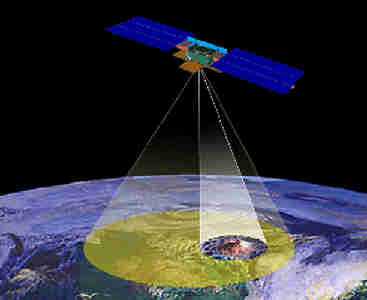
Back to the Space Place Index
Sciencecraft
by Patrick L.
Barry and Tony Phillips
Probes that can distinguish between "interesting" things and
"boring" things are vital for deep space exploration, say
JPL scientists.
Along with his colleagues in NASA's Space Technology 6 Project (ST6),
JPL's Steven Chien is working to develop an artificial intelligence
technology that does just that. They call it the Autonomous
Sciencecraft Experiment, and it's one of many next-generation
satellite technologies emerging from NASA's New Millennium
Program.
As humanity expands its exploration of the outer solar system-or
even neighboring solar systems!-the probes we send suffer from two
unavoidable handicaps. First, commands radioed by mission
scientists on Earth take a long time to reach the probe: six hours for
the planned New Horizons mission to Pluto, for example.
Second, the great distance also means that data beamed back by the
probe trickles to Earth at a lower bandwidth-often much less than an
old 28.8 kbps modem. Waiting for hundreds or thousands of
multi-megabyte scientific images to download could take weeks.
And often many of those images will be "boring," that is,
they won't contain anything new or important for scientists to puzzle
over. That's certainly not the most efficient way of using a
multi-million dollar probe.
Even worse, what if one of those images showed something extremely
"interesting"-a rare event like a volcanic eruption or an
unexpected feature like glaciers of methane ice? By the time
scientists see the images, hours or days would have passed, and it may
be too late to tell the probe to take a closer look.
But how can a probe's computer brain possibly decide what's
"interesting" to scientists and what's not?
"What you really want is a probe that can identify changes or
unique features and focus on those things on its own, rather than just
taking images indiscriminately," says Arthur Chmielewski, one of
Chien's colleagues at JPL.
Indeed, that's what Chien's software does. It looks for things
that change. A mission to Jupiter's icy moon Europa, for instance,
might zero in on newly-formed cracks in the ice. Using
artificial intelligence to set priorities, the probe could capture a
complete movie of growing fractures rather than a single haphazard
snapshot.
Until scientists can actually travel to deep space and explore distant
worlds in person, they'll need spacecraft "out there" that can
do some of the thinking for them. Sciencecraft is leading the way.

The Autonomous Sciencecraft technology that will be tested as part
of NASA's Space Technology 6 mission will use artificial
intelligence to select and transmit only the scientifically
significant images.
Learn more about Sciencecraft at
nmp.nasa.gov/st6. Kids can make
a "Star Finder" for this month and learn about another of the ST6
technologies at
spaceplace.nasa.gov/st6starfinder/st6starfinder.htm.
This
article was provided by the Jet Propulsion Laboratory, California
Institute of Technology, under a contract with the National
Aeronautics and Space Administration.
|
About LUNAR |
Home |
Calendar |
Contacts |
Old Gallery |
Member Pages |
Events |
Presentations & Docs |
LUNAR'clips |
Handbook |
Space Place |
Mailing Lists |
Joining |
Other Rocketry Pages |
Site Map |
Frames |
All content is the responsibility of LUNAR.
If you have comments or suggestions regarding these web pages,
please contact the 
Copyright © 1992 - 2025 LUNAR



